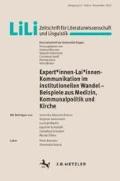Summary
The analysis of three incantations from widely differing sources — a Mesopotamian baby charm, an Old English herbal incantation and a Baroque charm against an infant disease — shows that ›magic‹, so called, at least in its early forms, is a thoroughly rational instrument for mastering the world and its vagaries, bringing together human happiness/suffering and the power to act. The logical consistency of the incantations, which are, in part, very subtle in their construction, is revealed through the decoding of complex variants of a mode of thought which can be traced back to the documented origins of magic in the ancient Orient and which can still be seen in the incantations of the New Age: that all things and all creatures constantly radiate a material ›aura‹ of varying quality, which can be tapped into through touch so that desired characteristics can be transferred onto deficient (›sick‹) subjects/objects in need of transformation: thus, according to this mode of thought, a new code (›health‹, ›order‹, etc) can be implanted.
Similar content being viewed by others
Eingesandte Literatur
Clivio, Gianrenzo P./Pasero, Dario/Pich, Censin (Hg.): XIV e XV rëscontr antërnassional dë studi an sla lenga e la literatura piemontèisa (Quinsnè, 10ē11 magg 1997 e 9ē10 magg 1998), Ivreja (La Slòira) 2002.
Clivio, Gianrenzo P.: Profilo di storia della letteratura in piemontese. Torino (Centro Studi Piemontesi) 2002.
Deutschsprachige Hörspiele 1924ē33. Elf Studien zur ihrer gattungsgeschichtlichen Differenzierung. Hg. Helmut Kreuzer. Forschungen zur Literatur- und Kulturgeschichte. Band 73. Hg. Helmut Kreuzer, Karl Riha u. Ralf Schnell. Frankfurt/Main: Lang Verlag 2003.
Didaktik der Physik. Aufgabe in Lehre und Forschung. Siegener Studien Bd. 60. Universität Siegen 2002.
Eschenloer, Peter: Geschichte der Sadt Breslau. Hg. Gunhild Roth. Münster u.a. 2003 (Quellen und Darstellungen zur schlesischen Geschichte 29/I u. II).
Hölderlin Handbuch. Leben — Werk — Wirkung. Hg. Johann Kreuzer. Stuttgart/Weimar: Metzler Verlag 2002.
Huszai, Villö: Ekel am Erzählen. Metafiktionalität im Werk Robert Musils, gewonnen am Kriminalfall Tonka. München: Fink Verlag 2002.
Karl Riha: Anfänge — Ausklänge. Karl Rihas frühe »Diskus«-Schriften und Dokumente zur Eremitierung. Nichtfestschrift. Hg. Peter Gendolla u. Carsten Zelle. Frankfurt/Main: Lang Verlag 2002.
Kontinuum der Zeichen. Elisabeth Walther-Bense und die Semiotik. Hg. Udo Beyer und Karl Gesser. Stuttgart: Metzler Verlag 2002.
Lehrerbildung in Siegen. Siegener Studien Bd. 61. Gesellschaft zur Förderung der Lehrerbildung 2002.
Literarische Fundstücke. Wiederentdeckung und Neuentdeckung. Festschrift für Manfred Windfuhr. Heidelberg: Universitätsverlag Winter 2002.
Loescher, Jens: Mythos, Macht und Kellersprache. Wolfgang Hilbigs Prosa im Spiegel der Nachwende. Amsterdamer Publikationen zur Sprache und Literatur, Bd. 151. Amsterdam/New York: Radopi 2003.
Maack, Ute: Ironie und Autorschaft. Zu Friedrich Schlegels Charakteristiken. Paderborn: Schöningh Verlag 2002.
Mieder, Wolfgang: Verkehrte Worte. Eine Sammlung von Anti-Zitaten aus Literatur und Medien. Hg. Gesellschaft für Deutsche Sprache. Wiesbaden: Quelle & Meyer 1997.
Professionalität und Kommunikation. Medienberufe zwischen Auftrag und Autonomie. Hg. Michael Krzeminski. Köln: Herbert von Halem Verlag 2002.
Reich-Ranicki, Marcel: Erst Leben, dann Spielen. Über polnische Literatur. Göttingen: Wallstein-Verlag 2002.
Rennhak, Katharina: Sprachkonzeption im metahistorischen Roman. München: Fink Verlag 2002.
Schriftsteller und Rundfunk. Hg. Jörg Hucklenbroich u. Reinhold Viehoff. Konstanz: UVK Verlag 2002.
Stern, Gerson: Weg ohne Ende. Ein jüdischer Roman. Mit einem Nachwort und einem Glossar von Friedrich Voit. Siegen: Carl Böschen Verlag 1999.
Walther, Elisabeth: Zeichen. Aufsätze zur Semiotik. Weimar: Verlag und Datenbank der Geisteswissenschaften 2002.
Author information
Authors and Affiliations
Corresponding author
Rights and permissions
About this article
Cite this article
Schulz, M. Nigon wyrta galdor. Z Literaturwiss Linguistik 33, 8–24 (2003). https://doi.org/10.1007/BF03379346
Published:
Issue Date:
DOI: https://doi.org/10.1007/BF03379346




